Downtown Medellin sits in the bottom of a valley 1500m up, the air is cool at night and there are no mosquitos to contend with. The city sprawls up the surrounding mountains like a white paint high water mark; huge concrete tower blocks built on steep slopes like nowhere else I have ever been. At night the lights surround you from almost every direction, and where they stop the stars begin. Driving the high road back and forth from the airport to collect and drop off Naomi, we had been able to see the city in every type of light and it was stunning. Leaving the city meant we had to climb the best part of 1000m in one chunk, working our way between these steep outer areas. After two hours in the saddle we were rewarded with a view across the whole city whilst being able to see both up and down the valley itself. It was a beautiful farewell to a place I’d always wanted to visit. One week in and around town hadn’t disappointed. From cool parks teeming with wild Iguanas, to steamy raves blasting out blistering techno, it had been incredible, yet after seven days we now both felt ready to move on.
The road twisted free of the city fringes come the early afternoon, rewarding us with pristine lakes and green fields. We put in a solid shift riding that day, enjoying the lasts of what the mountains had to offer. Arriving in Santa Rosa de Osos just after dark, we went over to the local firestation or ‘bomberos’, as they are known in Spanish. They were more than happy for us to pitch our tents on their land, so we laid out our stuff, with me enjoying watching Rodrigo attempting to pitch his non freestanding tent on a concrete floor, whilst mine sat satisfyingly upright (note to anyone looking do embark on a bike tour, make sure you buy a freestanding tent – it will save you so much hassle!)
The next day saw us enjoying the very last of the fresh Andean air. Just out of town we met a pro cycling team out for a training ride. They slowed to our pace for a nice chat, asking what we were doing and where we were going. They were out here for pre season training before kicking things off properly in the States. The Tour de Colombia was going on right now, and we had been eagerly following the action, so hanging out with some pro cyclists (be them ones we hadn’t heard of) was really cool. After continuing on the road and waving bye to the pros who had gone ahead and were now riding home in the opposite direction, we found ourselves following a beautiful but busy ridge line road. Seeing a small offshoot that supposedly linked to the next village, we set off away from the busy traffic of the main road. We weaved around a large road block which we assumed was a remnant from the protests one month previous, and passed a few shouting locals. Riding along the empty road we both suddenly slammed on the brakes, ‘shit, shit, shit!’. The road just disappeared. Six feet away from our front wheels the tarmac just fell away down a cliff. About 50 feet of road was missing and we had nearly cycled off of it! So now the roadblock and shouting made sense – what muppets we had been.


We quickly retraced our steps, rejoining the road past the ‘I told you so’ers’. From here we lapped up the last of the days golden sun, following the weaving road as it wound down what would be our final descent of the Andes. As a mountain range that I had followed entirely for the last three months, I was sad to see the back of it. I have been lucky enough to ride a few awesome ranges over the course of this trip, and I can honestly say that my time in the Andes has been my most enjoyable. The rugged rawness of the mountains, the ability to explore remote gravel tracks and to reach those high altitudes – there’s no other place like it. The Karakoram may be the most beautiful, the Pamirs have that amazing culture, New Zealand boasts incredibly accessible wilderness, but South America feels like the best balance. If you have the time not to rush through, riding the Andes is a true adventure in every sense. The northern part which I rode, I could go west and end up in the amazon, follow the spine and experience glaciers and high roads, or go east and find myself yo-yoing up and down switchback filled valleys. And then you have the South American people, always up for playing music, dancing and drinking. As a westerner, it’s easier to understand and integrate with their culture, whilst still finding its nuances intriguing. I know my next trip will be back to Peru, heading south across Bolivia and down to Patagonia, and I’m already excited for what that might bring.
Continuing on north however, we descended out of the Andes. Immediately we felt the heat we’d been told about by locals from the mountains. They had shaken their heads and ruffled their shirts with remarks of ‘caliente’, meaning hot, when we told them where we were heading. That is how I would sum up the next three days – hot, very hot. There were no more mountains to gawp at, no more switchbacks to climb or descend, only muggy air to push past. The terrain undulated enough in places that we weren’t able to speed along like we’d hoped, and the temperature soared way above 40 degrees. It was just a case of trying to put in hours on the bike and not let ourselves get too dehydrated. Some days we found ourselves riding an hour or two in the evening darkness as a respite from the searing heat of the day. Yet, even cycling without the sun, we found ourselves soaked in sweat with the increase in humidity that came with the night.
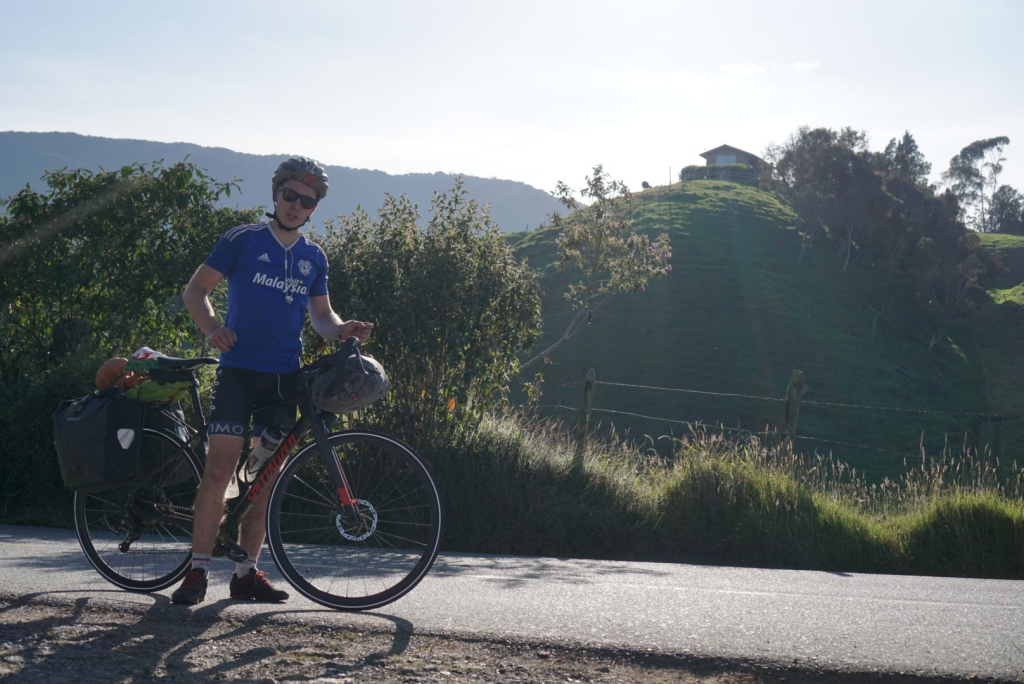

It was now all about reaching Cartegna, the district capital right up on the coast. One day out from our goal, we arrived at the UNESCO heritage village of San Basilio de Palenque – an Afro-Colombian community – in the dark. When the Spanish came to conquer South America, they brought with them thousands of African slaves, to which the inhabitants of this town were descended from. Culturally they carry with them African traditions and even have their own Palenque language. Despite being a heritage site, we couldn’t find anywhere to stay, and were starting to feel a little on edge about the place. One guy asked what we were doing and I asked if he knew of a place to stay. He started off down the road to where a supposed hotel was and we had no real choice but to follow. Me and Rodrigo glanced looks, ‘if he goes down an alley or somewhere too dark we don’t follow…’. We came to a big metal gate where the guy made some calls. Eventually a woman came out and opened up a yard for us. There were a couple of rooms inside this small two storey block for which they wanted to charge us a small fortune (for Colombia) to stay in – the perils of arriving in the dark. We decided even at this late hour, they were being ridiculous with the price, switching our lights back on and mounting our bikes, secretly hoping they would drop the price. Quickly the number halved and we happily accepted the still slightly inflated offer.
I made a case of giving our ‘guide’ a tip on the side so as to keep him sweet, as I had a strange feeling about the place and wanted him to stay on side. He kept jabbering on about something, but the Afro accent combined with fast Spanish made it almost impossible to understand (we later found out that a lot of the non-afro colombians also struggle to understand this accent and slang also). We left him be, locked the gate and went to bed. In the middle of the night, we woke up to a banging on the corrugated metal roof. Outside was a guy shouting, the same guy who had brought us here – bloody hell. He was throwing rocks onto our roof and screaming from outside the gate. We had made a point of double locking your door and taking a room on the second storey so as to be a little harder to reach, so we just laid low and made no noise. Eventually he left us be – what a strange place.
The next day we rode out of town first thing, keen to put some miles between us and the town. We stopped to get out of the heat of the day, ending up paying frisbee with some local kids by a shopping centre. They were bemused by the two cycling gringos, and even more so when we produced a bright orange frisbee from one the panniers. The highlight was one of the kids fumbling a catch, sending the frisbee clattering into the glass door of a cafe to his dismay. With the locals rattled, we got back on the bikes, putting in the last 20km’s of South America. A huge offshore wind pinned us back for the final kilometres, leaving us crawling along the coast road to the famous Cartegna sign at walking pace. There it was, the end of South America. I had seen this sign pinned on many people’s instagram pages for months now. To many it marks the start or finish of a great adventure, to us it closed out a special section of the ride. A quick photo in front of the sign and then over to a hostel to treat ourselves with a proper sleep.
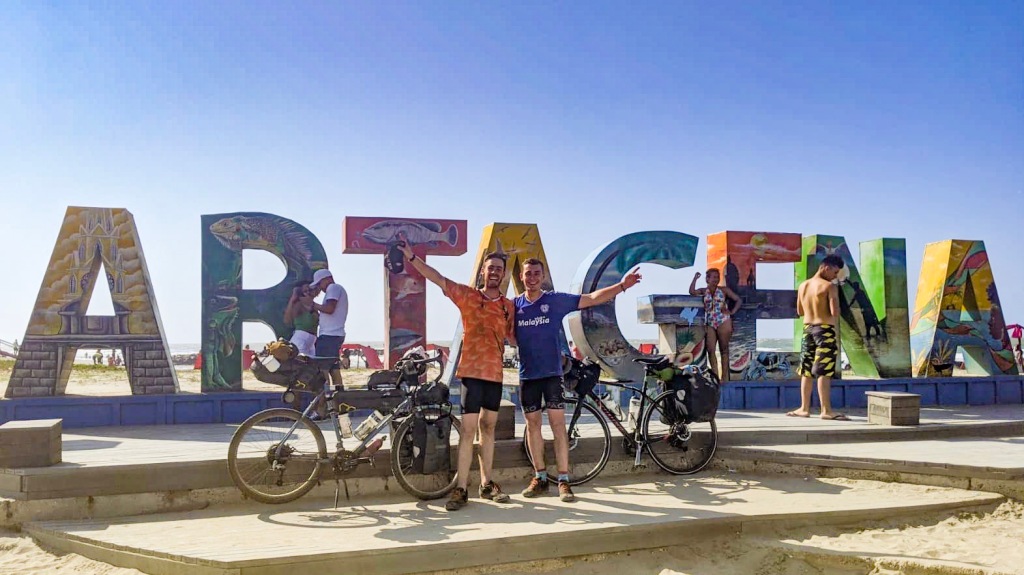


We had arrived in the city a little quicker than anticipated, leaving us five days before we intended on flying out. This left us plenty of time to explore the quaint old town with other travellers from the hostel. One night we were out with a couple of Norwegians, enjoying a few supermarket beers in a local park when a stout old man came up to me and asked where we were from. After going through the group he immediately broke into Norwegian, asking the girls with us if they knew of these tiny towns in their country. They couldn’t believe it, he could list off these tiny villages close to their own neighbourhoods in their mother tongue. It’s very rare to find any traveller who is Norwegian, let alone an afro-colombian who fluently speaks the language. We invited the guy to join us for a beer, listening to his stories of sailing all over the world, often living in countries for years for his work. He asked if he could borrow the girls phone to call someone from Norway, and so he called up some random woman, with whom it was 5am and asked her when she would next have work. It was all hilarious. And that was how we met Delmiro.
Over the next days we saw Delmiro at least once a day. He knew everyone in the town, even managing to pull some strings to get us on an island boat trip for a third of the advertised price. In turn we took him out for dinner with us, to which we were greeted with smiles by the locals. Delmiro, or Del (short for del-boy as he was now known), had asked us what we were doing riding bikes and where we were going. We told him about flying to Panama, complaining of the the extra $120 price they were asking to take our bikes. He laughed, saying he could get us on a ‘banana boat’ for that price. Naturally we were intrigued, asking him to tell us more. And so it began. A simple sentence that kicked off a crazy chain of events. Flying to Panama now seemed boring, we were keen for a new adventure.
Over the next days Del contacted old friends, friends of friends, police officers and sailors to put in a plan for us to get to Panama. We decided to miss our flight and roll with this haphazard plan – we trusted him after pulling through with our island trip. The next day we chucked our bikes on the first bus from Cartegna to Monterrey; it promptly broke down at the side of the road. We then forced our bikes onto a replacement bus that was already full of people. Sitting on the steps at the front of the bus we made our way to the city where we had been told to meet a policeman at the bus station. Of course the policeman wasn’t there, and there were no buses going to our next destination of Turbo that day. We grabbed a bed at a cheap hostel for the night, all ready for an early start the following morning. In the hostel we spoke to a Brazilian guy who was working there. He told us that he had also tried to get a boat from Turbo to Panama, but instead had been drugged and robbed in the bus station in Turbo in the middle of the day. He warned us that under no circumstances should we go there. Shit.


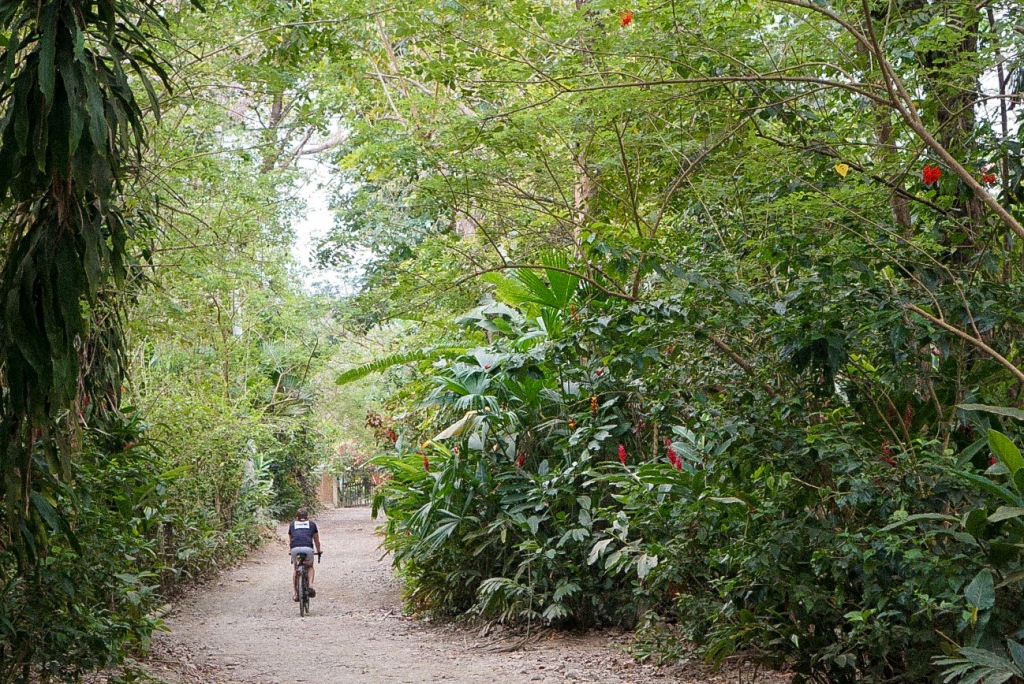
‘I promise you there are bandits everywhere and they will try and go for you. With those bikes you are sitting ducks.’ After a quick google, what he said seemed to add up – could we get a boat from anywhere else? He recommended another port in the town of Necocli, it was safer there he said. Now Delmiro’s warnings not to arrive in Turbo in the dark made more sense. I’ve often found this in countries where you have to be a little careful, when you explicitly ask if it’s dangerous they shy away from telling you the whole truth. Instead they say no but with a caveat of not staying out at night ‘like anywhere else’. I heard this in Pakistan where people deemed it necessary to provide armed guards outside our room at night, ‘oh no sir it’s not dangerous here, I just thought it would be best to stay outside your room all night with a shotgun to be sure though…’ I had been keen not to take longer than necessary to get to Panama, so taking two buses in a single day to Turbo made sense. Del had said not to do it, ‘take your time’ he’d said, and now we really understood why. Turbo was territory of the old (and now disbanded) FARC, but was also full of Venezuelans fresh out of the terrible situation in their home country, and left in a desperate situation. It wouldn’t be smart as two gringos to try our luck down there.
The following morning we went down to the bus station, tying our bikes to a comically small minibus roof before heading to Necocli. The one boat of the day to the jungle town of Capurgna had left just an hour ago, so we found a place to hole up for the day. Luckily we found a real nice hostel (Casa Neco) ran by a French guy and his Colombian wife. We looked around the pretty little beach town that afternoon before taking out cash; there would be no ATM’s where we were going. Down at the seafront the next day it was carnage. Hundreds of people were trying to catch the boats and getting our bikes on board started to look very questionable. I couldn’t understand where all these people had come from, the town had been dead the day before yet it was madness down here. We found out that 95% of these people were migrants, looking to illegally cross into Panama on route to the US. Getting a boat to Capurgna cut out a large section of the dangerous Darien jungle, leaving them approximately a week of treacherous walking through to any type of road in Panama. The Colombian government just wanted rid of these migrants and therefore make no effort to stop them crossing.
We were told to take the first boat, with our bikes to be loaded onto a second migrant boat. We desperately didn’t want to leave our bikes in Necocli whilst we jetted off, but no matter how much we argued, we couldn’t budge them. The boat ride was an experience in itself. For two hours the boat smashed its way over the rough sea, causing most people onboard to be soaked from head to toe. Others were throwing up with their head in their hands. Sitting right at the front we were spared from the worst of the water, but instead we were properly winded a few times as the boat crashed through steep waves. Arriving in Capurgna, everyone was more than happy to be back on dry land. We made our way to a small guesthouse and ran through what we knew was to come. We were to pick up our bikes from the jetty that would arrive on this ‘second boat’, then catch another far smaller boat around the two adjacent bays to Panama where we would be stamped into the country, then we needed to take another seven hour boat to a place called Carti. From Carti we could get a 4×4 through the jungle to Panama. We knew the boats to come would be much smaller than the one we had taken here, and the sea could only be rougher the further out we went. It was starting to seem like a terrible idea.



Thankfully our bikes did turn up on the jetty as promised, and were even rideable back to our little hostel. We enjoyed the tranquility of the beautiful place we found ourselves in, as we anticipated the next days would not be so kind to us. Reading online, we found that we were in amidst the ‘rough season’ for crossings, and that we may have to wait days until we had enough people wanting to catch the boat onwards with us. We were in too deep at this point, Del’s plan of a tranquil banana boat was now just a hazy memory on a wave filled horizon. Thankfully, the next day we were able to catch a boat across the border to the first Panamaian settlement of Puerto Obaldia with a French guy who had overstayed his 3 month Colombian visa. The boat dropped us off about 20 metres from shore, so we were left to carry our bikes above our heads through the incoming waves before coming back for our bags. On shore our bags were thoroughly searched for drugs, then we penguin waddled under the weight of carrying all our gear to the passport office. We got two photocopies of our passport from an adjacent building for a dollar a piece before we could be officially stamped in.
Puerto Obaldia is essentially just a military base. The personnel here guard the border and attempt to stem the ever flowing stream of migrants who cross in the depths of the jungle. Like Capurgna, there are no roads in or out. There is a small airstrip which the military use, and we had been told you can fly directly to Panama city from there on a small plane for a hundred or so dollars. With our bikes however, a boat would be the only way out, but luckily we were told there was one going today. We lugged all of our gear back to the jetty next to where they had searched us, as a tiny fibreglass dingy, complete with two oil barrels full of fuel, pulled up. The guys dropped the anchor before wading ashore to be briefed by the army. We were to pay $120 each as we were the only passengers on the boat. It would be a very rough crossing, taking at least three hours longer than the usual time. With the most dangerous jungle in the world in the form of the Darien on one side, and an incredibly rough sea on the the other, we were to hold on tight – you didn’t want to be getting into to trouble over here.
Whilst talking to the army, the supposedly anchored boat began turning around dramatically in the waves. The two drivers bolted back down the beach, jumping into the water to try and stop the boat being smashed into the rocks on the beach or being flipped in the waves. If there’s something you don’t want to see when about to embark on a seven hour rough crossing of a remote region, it’s your drivers cocking up a simple anchorage in a protected bay… After regaining control they span the boat round to the jetty and we literally dropped our bikes into it before jumping down ourselves. I held tight to a wad of dollars that was our ticket out of here, in my head I could see them blowing away in the strong wind, leaving us well and truly screwed. I passed the money up to the army chief who took $40 for himself and handed $200 to the the drivers. It was obvious that the drivers were getting slightly shafted given the nominal role of the chief in this venture, but no one batted an eyelid – this was just how things worked.
So it began. One arm holding the bench in front of us, the other holding the plank beneath, one finger looped around a fastening of the lifejacket so as to keep the back from riding up and exposing your spine to a grating against the solid backrest. Fail to do one of these properly and you were in for serious pain. Fail to hold on to the boat properly at all and you would certainly no longer be in it. I tied the bikes down with a series of bungees so taught they could have slingshotted one of us the distance to Panama city, yet as we set off, somehow the bikes were still getting airborne on every wave – this was not a joke. Our drivers were also not enjoying the ride, falling into a tense silence bound by respect for our shared discomfort. The boat was so small and the waves so big, that you couldn’t just chug through them. The boat had to be steered up the shallowest point of the wave before accelerating along the trough and then steered up the next one. Even with this acceleration, deceleration, steer into the wave routine, the whole thing was horrible game of cat and mouse. Riding over the shallowest point still saw us catching serious air time and smashing flat into the bottom of the next trough, so at no point was it plain sailing.
After the drivers made their first switch at the helm, we found the waves around us breaking towards the boat. A quick stop allowed the first break to ride in front of us, but soon a second one just clipped the bow, knocking the boat 180 degrees in the direction of the travelling wave. There was a lot of noise from the drivers who hurriedly switched back and gunned the boat towards the shore with the waves. The boat was surfing down the face of the waves, with the small breaks pushing water over the lip of the stern. After getting back into safer waters we began smashing our way over the waves again. This went on for hours and hours. Time warped into insignificance as the grey skies hid the sun from revealing any clues about how long we had been going. Our phones were secured in dry bags clipped around our belts, along with anything else valuable. We daren’t open them as it would mean removing one hand from the boat. Instead we just hunkered down, discussing what food we would most like to eat once this ordeal was over.
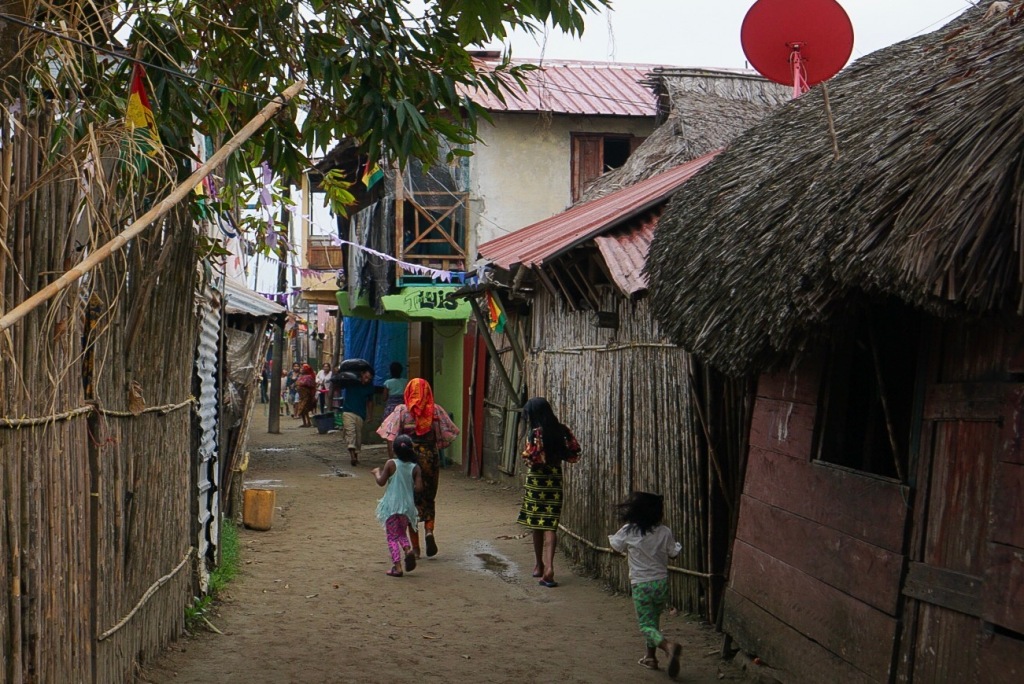
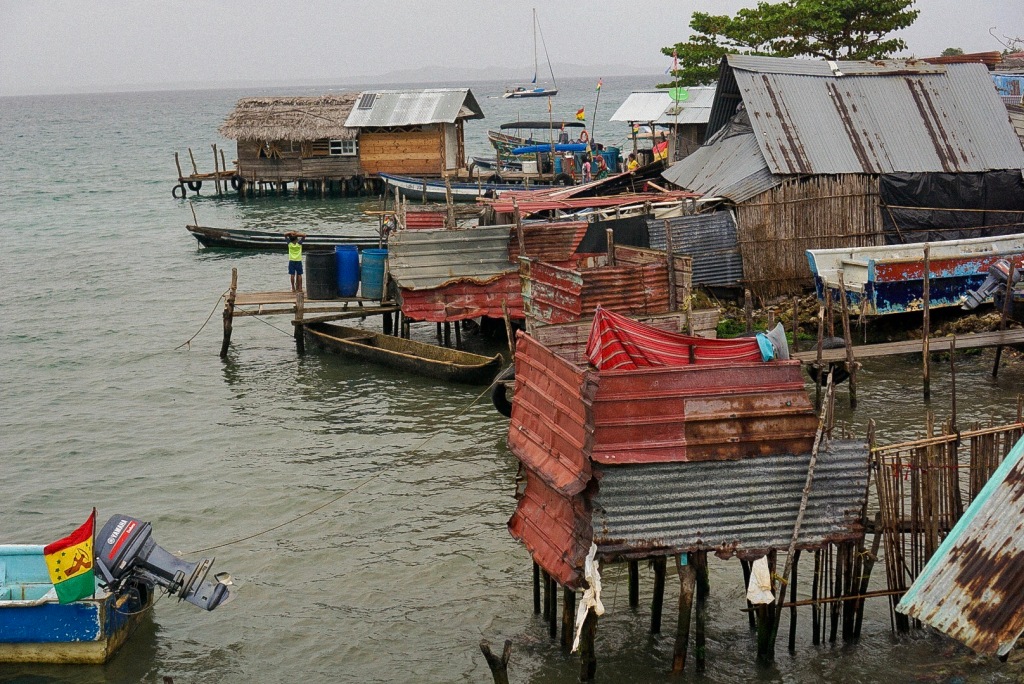
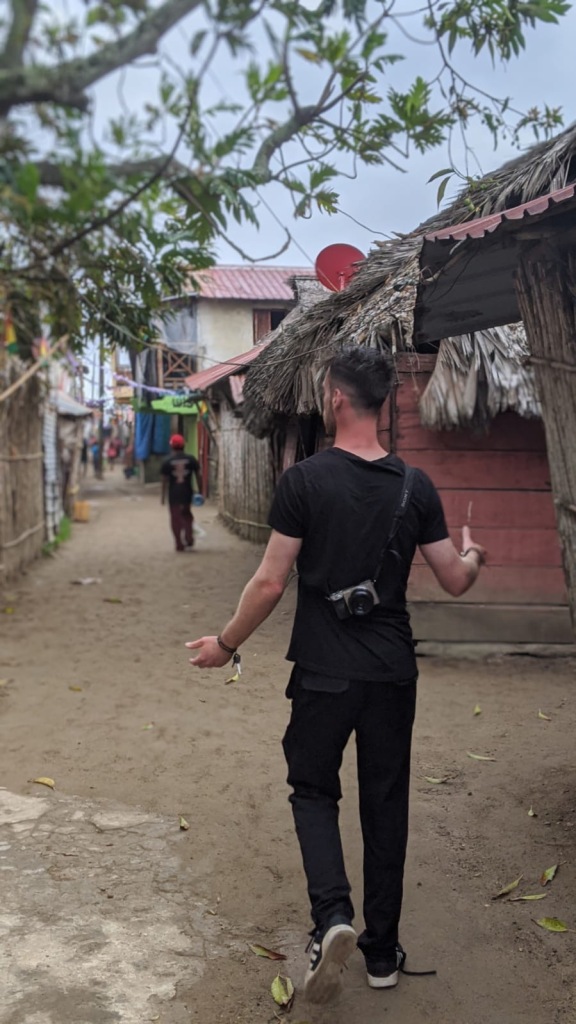

At one point we hid behind one of the small San Blas islands. Every inch of the island was covered in these wooden huts belonging to the local Kuna people, who we watched rowing back from the jungle in small canoes. Behind the island we were sheltered from the big waves, allowing us to speed along for the entirety of 10 minutes. Then we were back to grind for an unknown number of hours. After what felt like a long time it decided to rain on us, not that it made much of a difference, we were already soaked from the sea spray. Eventually we pulled up close to an island, with the drivers making a beeline for a small jetty. I had read about drivers dropping people off on random islands, demanding more money for the journey, and so was wary of what was happening. We just had enough cash to pay for the jeep needed to get us from Carti to Panama City, and so didn’t have any room to wiggle here. They drivers said we would land at Carti the following morning and that we were all to stay here tonight. So here we were, stuck on a random island with a population of indigenous Kuna people, not entirely sure if this day had been real. I checked the offline map on my phone, Carti was only 5km’s away – it seemed like we were going to make it through.
That evening we went out to look around the island. What we found was amazing. The island was a packed labyrinth of small walkways between small houses made out of odd pieces of wood and corrugated metal. The locals have no beds, instead sleeping in hammocks. We were invited to look around a tiny museum by one of the locals, before joining them for a religious gathering of the women that evening. Two Shamans sat in hammocks in the centre of this medium-sized wooden structure, singing these strange songs. Apparently they are singing a story that teaches the people about some of their religious teachings. The ceremony that night was just for the women, with the following night being for the men. The society of the Kuna’s is Matrilocal, and the women dress in these colourful clothes and have their noses pierced with a gold ring. One of the locals told us that the Kuna people live incredibly long lives due to their diet of vegetables and fresh fish. When they eventually die their bodies are taken to a tomb with a hammock set up inside for them to rest – all of which is underground. They also construct a small wooden boat known as a ‘soulboat’, which they release into a river, this represents the souls journey to the afterlife. It all sounded so beautiful.
It was a truly amazing evening, learning about about a culture and people with whom I had never heard of. Watching them prepare for the anniversary of their revolution fighting off the Panamanians for their independence was incredible. The young boys ran around the village in formation, shouting orders as they marched holding fake wooden guns. They asked us to join them, so we did a lap of the tiny island in tow, pinching ourselves the somewhat as to what was going on. If the buses and boats had been the journey from hell, then this magical evening more than made up for it. There was not a single foreigner on this island, and judging by how many heads we were turning, they didn’t often see any. We eventually retired to our tiny ‘room’, it was really just a bamboo divider that separated a larger room, crashing out immediately.
The next day we took the boat across to Carti, loading our bikes atop a 4×4 that would take us to Panama. When we finally arrived in the cosmopolitan city where bank buildings scraped the sky, we could barely believe the journey we had been on the past few days. Tired was a gross understatement, we were wrecked. Our bikes were in similar shape, pieces of axle had been lost to the sea whilst the drive chains were showing some serious signs corrosion. We set about reassembling them before heading down to the bike shop to pick up the missing parts. Although we were shattered, the extra five days journeying to the city meant we no longer had the luxury of time. Days from here on needed to mean miles, starting right from the off. It all sounded so simple, yet, of course there was something we hadn’t factored in…

I visited the kuna Indians on Ustupu San Blas October 1979 – stayed a week waiting for a boat to Turbo (travelling south) wonderful place amazing people.
LikeLike
Wow Mike, that must’ve been a heck of an adventure! I hope the weather was kinder to you than we found it!! We loved the Colombian people also – such a happy, fun country
LikeLike